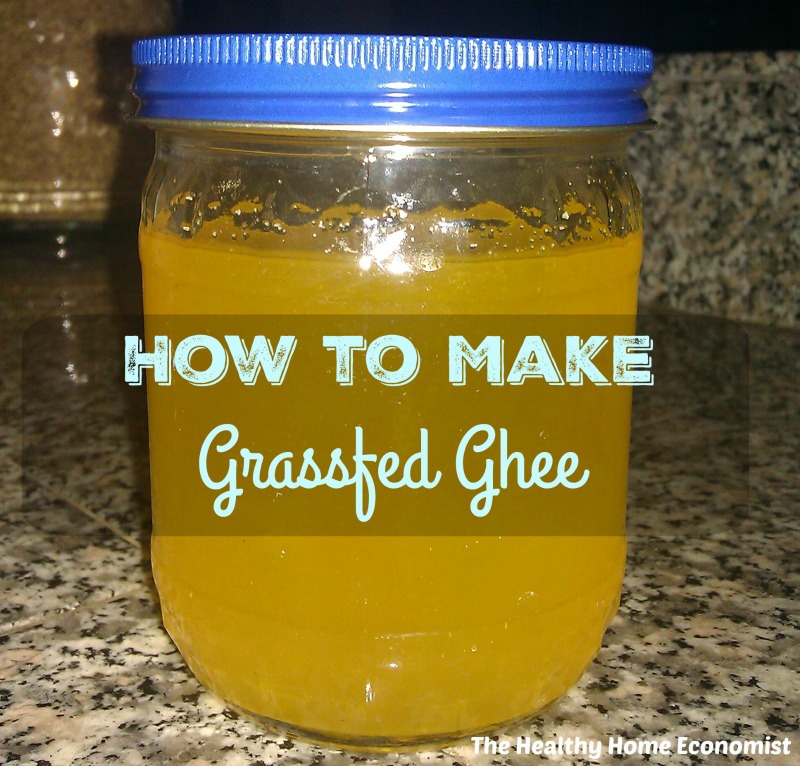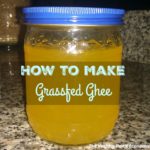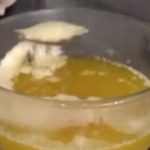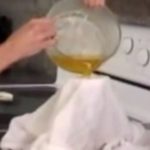Table of Contents[Hide][Show]
How to make homemade ghee on the stovetop quickly and easily for a healthy cooking fat that is shelf stable and nourishing.

Knowing how to make ghee is simply a must for any Traditional Cook. Clarified butter as it is also known, has been used for thousands of years by Indian cultures. In fact, traces of ghee have been found on fragments of Indian pottery dating as far back as 6500 BC!
When in a liquid state and made from unheated butter, ghee is called butter oil. Dr. Weston A. Price discovered that butter oil and cod liver oil work synergistically to supercharge absorption of Vitamins A, D, and K2 known as the X-factor.
Dr. Price always carried flasks of cod liver oil and butter oil to the bedside of very ill patients. More often than not, he was able to revive them with a few drops of each under the tongue. Using cod liver oil or butter oil separately did not have the same deathbed reviving effects.
Benefits of Ghee over Other Cooking Fats
It is best to know how to make clarified butter oil or ghee yourself rather than buying from the store. Notice the picture above of a jar that I made myself with pastured butter from a local farm. It is so yellow!
Commercial ghee from the store is a pale yellow, indicating lower nutritional value from cows eating grain mix instead of fresh green grass.
Ghee from the store is also ridiculously expensive, so learning to make it yourself is not only a more nutritious way to go, it is very cost-effective.
I make clarified butter oil for about half the cost of what it would be to buy it at the health food store.
Unlike butter, ghee does not need refrigeration and keeps well on the counter or pantry for many months. Keeping a jar in the pantry for a quick veggie saute is very convenient!
Another benefit of ghee is that it is easier to digest as all the milk solids (proteins) have been removed from the butter. Very frequently, even those with a true dairy allergy find that ghee presents no trouble for them.
Another advantage to using clarified butter instead of plain grass-fed butter is that the grassy taste and sometimes cheesy smell of the butter is eliminated.
Therefore, by learning to make clarified butter oil from grass-fed butter, you will find that you now have a healthy fat for cooking that does not displease your family with a cheesy odor. This can sometimes happen with grass-fed butter alone.
Homemade Grass-Fed Ghee
The recipe and video lesson below covers how to make this healthy and indispensable fat for use in your own kitchen.
I also cover how to make clarified butter capsules. This is a convenient way to take butter oil with your daily dose of cod liver oil.
If you are spending money on high vitamin cod liver oil (this is the brand I’ve used since 2015) it is a must to be taking it with clarified butter oil. This supercharges the beneficial effects!
Note that it is not advisable to make ghee from homemade raw butter. The heating process causes a loss of the enzyme and probiotics in this special food.
Prefer to Buy?
If after reviewing the recipe and video demo below you decide to buy instead, I would recommend this vetted source as a premier retailer of quality grass-fed ghee. Plain, cultured, and herb-flavored varieties are all available including a coconut oil/ghee blend.

How to Make Ghee
This simple recipe for making ghee can be accomplished on the stovetop in just a few minutes.
Ingredients
- 1 lb butter preferably grassfed and organic
- 1 wide mouthed mason jar quart size
- 1 cheesecloth fine mesh
- 1 funnel
Instructions
-
Place pound of butter in a medium sized pot or stove safe glass bowl. Turn heat on low and allow the butter to gently liquefy.
-
Turn heat to medium-low and gently remove foam that comes to the top of the melted butter with a slotted spoon.

-
After removing the foam, allow the melted butter to simmer on medium-low heat for 5-10 minutes longer to allow all the milk solids to settle out on the bottom of the bowl. You will know when the separation process is complete as the solids will be slightly brown on the bottom and the clarified butter will be completely clear and transparent.

-
Line a funnel placed into the open end of a wide mouthed mason jar with a fine mesh cheesecloth.
-
Pour the clarified butter into the funnel so that it is strained through the cheesecloth as it enters the mason jar.

-
Allow the finished ghee to cool in the mason jar. When room temperature, fasten the lid on tightly and store in the pantry as a convenient and incredibly healthy cooking oil for all your kitchen needs.








We’re not saying ghee is better than grassfed butter here. I am talking about having butter oil as a supplement with your cod liver oil each day. Ghee has the nutrients of butter concentrated as the milk solids are removed.
High vitamin butter oil is unheated. Cooking the butter to make ghee will make it no longer raw. Do you think this will destroy some of the vitamins that are supposed to be beneficial and effective in the cod liver and butter oil blend?
Ghee is butter oil … they are interchangeable terms in India. Butter oil is usually heated as in the form of ghee. Green Pastures is the only source of raw butter oil in the world that I know of.
Green Pastures is raw – yes, but is is unavailable. Ghee is the next best thing to take with your cod liver oil each day. Butter would not be closer as making ghee concentrates the nutrients by removing all milk solids.
I’m interested to know what makes ghee more effective than straight butter? I know they say that butter oil is more concentrated, but how does just removing the milk solids make such a huge difference? Surely eating 1/4 cup butter a day is just as effective (if not more effective) than taking small quantities of butter oil? Just curious…
Ghee, while a wonderful source of healthy fat, is highly heated, whereas butter oil is not, and has its high vitamin content intact. I would think grassfed butter would be closer to that than ghee.
Where I’m located, it’s difficult to get Green Pasture’s fermented cod liver oil/butter oil, even without it being back ordered. I have a 7 year old who seems to have her Dad’s teeth. In fact, we are on our way to the dentist because it looks like her back molars are turning brown. I was wondering, do you think a regular, high quality cod liver oil would be a help even if it’s not fermented? I called our local natural food supplement store (owned by a private naturopath) and they don’t carry fermented cod liver oil, nor butter oil.
I can’t play the video for some reason…:(
I bought skate oil instead, and have a freezer stockpile of raw cultured Jersey butter from June/July. I am good for a little while 🙂
Any opinion about nutrapro hvbo? A friend of mine takes it and seems happy with it. I make my own ghee anyway but it would be nice to buy in the winter when the cows in poland go indoors.